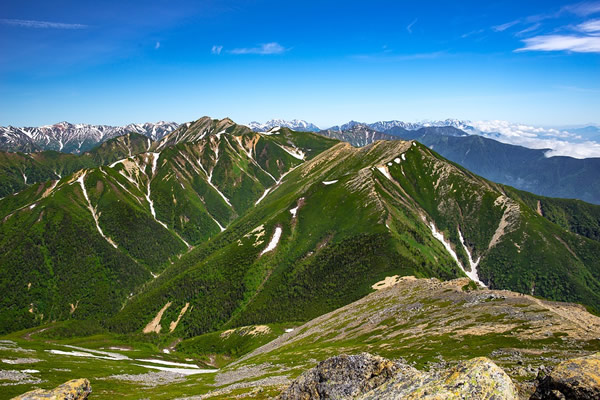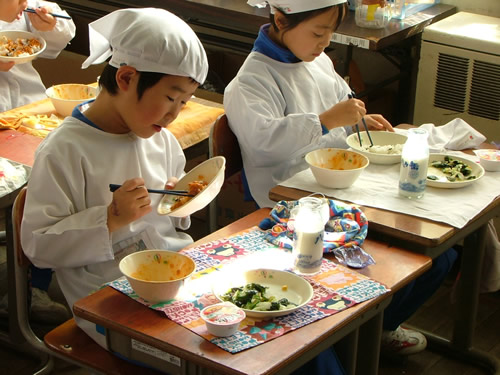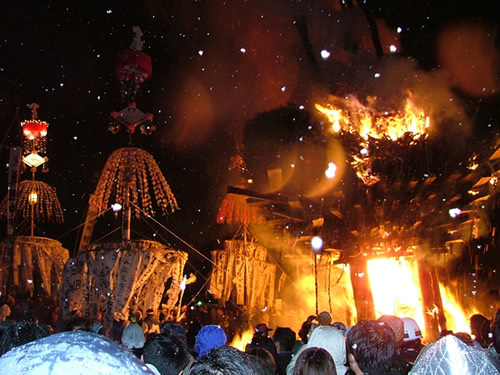Living Outside of Nagano, Japan
Happenings Away From the Metropolis
By Chris Gladden

|
|
Mountains outside Nagano in the winter.
|
Winter’s moved in, and snow lays heavy on the hills. Last night got down to -14 C, the coldest in quite a while. This is my 4th year living in the Nagano uplands of central Japan, and it has indeed become home. The cold here though is a different beast than I’ve tangled with before. In the land of ultra-modern cities, world class robotics, and to the minute high speed trains, housing in huge swaths of the country remains without insulation. Central heating is also a rarity, larger stores excepted. My place, for example, has the feel of a slightly glorified winter camp out. Which is not without its adventures. There’s something endearing about firing up the kerosene heater each morning while a plume of breath rises above your head.
About 11 AM we start the gradual drive up to Kirigamine, an undulating plateau at the edge of the Yatsugatake mountain range. Donning snowshoes we set out across the blanketed tablelands, open but for occasional patches of pine and stunted oaks. Though about a meter of snow covers the marsh and hills over which we plod, reeds and bushes poke their sleeping tops through the snow. Great dome of azure and meandering billowy white. Japan, one of the most densely populated nations in the world…not a soul or sound except a chirp and the distant wind moving over peaks and hills. Fuji-san rising prominently at the far end of a valley 100 miles distant. The piercing midday sun more like a flamboyant star, and everywhere luminous white. Peaks and peaks and the distant Japan Alps draped deeply in ice.
We make our way back to the car and wind down the valley to Suwa where we do what any sensible person does after a day in the snow. We take a nice, hot bath. One of the boons of Japan’s intense geological activity is that onsens, natural hot springs, abound. Onsens and the ritual surrounding them are definitely a high point of Japanese culture. Bathing is not meant simply to get you clean. In fact, you wash up before you enter the bath in a low stooled common area. Onsens are solely to luxuriate. As I slip into the neck deep geothermal pool, dads, granddads, little boys and girls move languidly about, float in the water, cool off in the corners. Late afternoon sun filters through the steam on a communal nakedness untouched by the puritanical wiles of the West. Here the simple fact of enjoying the bath together with your friends or loved ones is supremely important. And outside that, no one cares. “Kimochi.” “Feels good,” they say.
After drying off we move into the winter evening toasty warm, in search of beer and ramen. Ramen!! Not five for a buck packs of noodles, but the Japanese version, borrowed from the Chinese and then enhanced to create the fast food of the gods. A whole genre of television shows here is dedicated to its succulence. In any locale there are a handful of shops where a certain alchemy is practiced, and these are the ones that become rightly famous. The dance of long noodles in any number of hearty stocks with a variety of accompaniments can be sublime. All I can say is if you come to Japan, you’ve got to try this stuff. You’ll never think of Ramen as coming in plastic packs again. In the meantime, you might watch Juzo Itami’s film Tampopo, about an aspiring Ramen shop, and further the role of food in Japanese culture.
Bellies full we head to the pub, the izakaya. Dimly lit and smoky, raucous and J-pop blasting over the speakers we settle down on cushions before a low table. Our neighbors are a friendly lot, and the familiar banter begins. “Hey, your Japanese is great!” (It’s not.) Country? Job? How long in Japan? Then the conversation shifts to food, a major crowd pleaser. A rapturous 40 minutes or so is spent in that realm before I ask what they do. They’re architects. “Really? I’ve got a question for you...” I don’t know how to say “insulation” in Japanese, so I draw pictures, gesture, and explain all around the issue with the language I have. They get it. “So what’s up with the insulation?” “Well, in Japan we like to feel the four seasons. And also, families in houses without insulation are closer.” You think you’re starting to get your mind wrapped around the culture and snap, just like that, you’re spinning. Any rationalizations I might come up with would miss the point.
The next day I have classes, one day within a 5-day break. Teaching elementary school here is a blast. The kids are so fun and they absolutely love you. Lunchtime arrives. Students haul the food from the kitchen to the classroom, where they eat. Those in charge of serving don white jackets, caps, masks, and looking ready for surgery, dish out the grub. The food in Japanese schools tends to be hearty, healthy, and diverse, incorporating Japanese and non-Japanese fare. Ketchup is decidedly not a vegetable. Lunch in the public schools is always an experience of full cultural immersion, but today I’m in for a particular treat.

|
|
Children eating lunch at school. Photo by Chris Gladden
|
As we walk to the classroom a teacher asks, “Do you like kujira?” Whale. I thought this day might come. I’d heard rumors that it was “traditional food” week, but seeing we live in the mountainous center of the country I was thinking more marinated grasshoppers or wild boar. It’s not every day an ethical quandary falls so squarely on my plate, so I have to think fast. I realize it’s not just about my culinary preferences, ethics, or even the ecological facts. It’s about the students. I’m the only foreigner most of these kids have ever known (non-Japanese make up less than 1.5% of the population). And what I do is well noticed by all. Part of the reason I’m paid is to teach international understanding and my feeling is it’s important for the students to know not everyone eats whale. I don’t need to get into why. I tell the teacher in my most polite Japanese, “I’m really, really sorry. But I can’t eat whale. Today I’ll sit with the students, but I won’t eat.” She’s right baffled. Of course, folks have heard that many people outside Japan don’t eat whale, but to encounter a non-eater in the flesh is another matter entirely. I settle down to the pint sized desk and smilingly decline each passing plate. The lunchtime announcements come on, and as usual, they outline the fare. “Whale! So healthy and delicious! Such an important part of our tradition!” I feel a wavering, as though I’ve misread the situation entirely. Food is so central to Japanese life, and tabetai, “I want to eat it,” an ubiquitous refrain. Enjoyment is a virtue here, tabetai a sacred right. Food and ethics exist in different realms. Am I insulting them?
The teacher eats determinedly and silence falls over the room. I wish she’d say something, because wow, what a learning opportunity for the kids. But I’ve been here long enough to know that some of the most important messages are communicated through silence. They eat, I smile and joke, as usual. With puzzled grins the kids look to me and then to the teacher. Cultural bedlam. None of us knows what’s happening.
By the end of the meal the kids are talking. A crowd forms around my desk. What sport do you like? Do you have a girlfriend? Why didn’t you eat today? And I reply with a single word. “Kujira.” They don’t say anything, but I can tell they understand. They really do. Next question. On my way out, laughing, smiles, high fives for all. It’s clear we’ve passed through a trial together. And all things whale aside, we’re closer for it.
Two more days off. Board a local train for Nozawa Onsen, a hot spring town and ski resort a couple hours north. Dousojin, the village fire festival, is held every January. Based on old shinto rites for the local deities, it’s a raucous clash of fire and will. Men of two astrologically unlucky age groups cling to a make shift shrine. The villagers charge with fiery reed torches and attempt to burn it down. The unlucky folks must fend them off at all costs in a lengthy battle. Preliminary ceremonies can last several hours and are soaked in sake. Young men clinging to the shrine scream, “Bring on the fire! Bring on the fire!” as a river of flame bears down upon them.

|
|
Nozawa Onsen Fire Festival. Photo by Chris Gladden
|
Older guys snake through the festival grounds porting bottles of sake, bamboo shooters dangling from the neck. I’m offered a drink.
“What country?” “America.” “Oh! Obama!”
Time at hand the shrine’s set alight. I move in closer as the flames roar skyward. And I’m well warm.
|
For More Information On Getting Out of the Metropolis
Outdoor Japan
Area guide, onsen guide, activity guide sections and lots more. Covers the whole country.
Japanesepod101
Most innovative language learning tool on the internet. Daily lessons are free. Outside the big cities a little Japanese goes a long way.
Lonely Planet Japan
Their Japan guide is one of the best purchases you can make. Mine is in tatters due to constant use.
Nozawa Onsen Guide
Offers festival, onsen, ski info and more.
Jobs
O-Hayo Sensei is updated bi-weekly, covers the whole country.
GaijinPot has a decent smattering of all the kinds of practicalities, jobs included.
|
|
